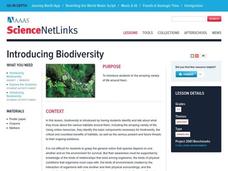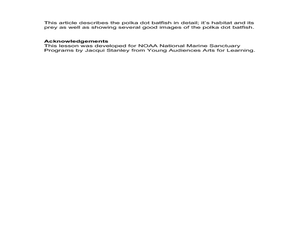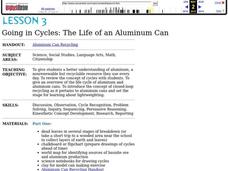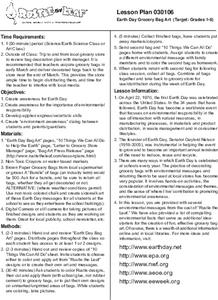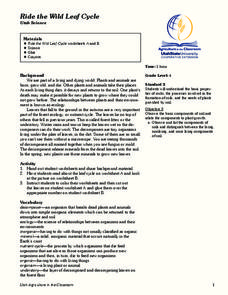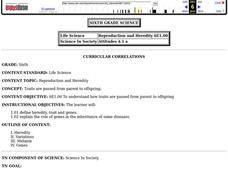Curated OER
The Human Organism
Eighth graders investigate animal behavior by studying the lives of three female behavior scientists. In this human organism lesson students do different activities that inquire and approach each females work.
Curated OER
Asexual Reproduction
In this reproduction worksheet, students identify the 5 major ways organisms reproduce asexually and list examples of organisms that reproduce in that manor. Then students complete 10 short answer questions.
Curated OER
Introducing Biodiversity
Students are introduced to the life around them. As a class, they discuss their prior knowledge about the habitats in their local area. Using the internet, they identify the basic components needed for biodiversity and the major...
Curated OER
Vibrating Objects Produce Sound
Students use many different materials and resources in order to study and identify sounds that are loud or soft, high or low, pleasant or unpleasant.
Curated OER
Pond 2: Life in a Drop of Pond Water
Students observe organisms found in pond water with a microscope. In groups, they discuss how single-celled organisms satisfy their needs for food, water and air. They compare and contrast the needs of macroscopic and microscopic...
Curated OER
Dinosaurs 1: Where Are the Dinosaurs?
Students explore dinosaurs and their extinction. In this dinosaur lesson, students view dinosaur websites and videos to gain an understanding of the world long ago. Discussion questions follow. Students create a paper mache dinosaur egg.
Curated OER
Home Sweet Home
Students examine the change in the diversity of animals living in an area before and after development. In order to do this, students need to have access to an area near their school which is undeveloped. A good, "real life" lesson.
Curated OER
Chemistry of Iron and Charcoal Manufacturing in PA
Students examine the historical purpose of the forests in Pennsylvania and investigate how the iron manufacturing process works. In this chemistry lesson students write the chemical formula for making charcoal.
Curated OER
Drawing Fish
Students practice creating art by imitating the camouflage of fish. In this animal characteristic lesson, students identify certain fish and their ability to change colors in order to survive in the wild. Students utilize coloring...
Curated OER
The Opposable Thumb
Students participate in an activity which helps them realize the importance of the opposable thumb through trying to live without it. The goal of this activity is for students to understand the physical importance of the opposable thumb.
Curated OER
Going in Cycles: The Life of an Aluminum Can
Students investigate the manufacture of aluminum cans and consider the energy and resources saved when the cans are made from recycled material. They explore the concept of closed-loop recycling using charts, worksheets and discussion.
Curated OER
Earth Day Grocery Bag Art
Students decorate grocery bags with messages aimed at increasing environmental responsibility. They deliver the bags to local grocery stores in time for Earth Day.
Curated OER
Tree Lesson
Learners compare and contrast characteristics of conifer and hardwood trees. After collecting samples of branches around the school, they classify the branch as hardwood or conifer. Groups of students identify given twigs. They go...
Curated OER
Ride the Wild Leaf Cycle
Fourth graders complete a worksheet. In this life cycle lesson, 4th graders learn about the leaf cycle and complete a worksheet where they put the leaf cycle steps in the correct order.
Curated OER
Flowers and a Beautiful World: Earth Day (1st)
First graders discuss Earth Day and making the world more beautiful. In this world beautification lesson plan, 1st graders participate in an interactive read aloud of Barbara Clooney's, Miss Rumphius. They talk about how making the world...
Curated OER
Plate Tectonics
Young scholars examine plate tectonics and landforms. In this plate tectonics lesson students complete an activity. Young scholars practice drawing maps that show different fault lines and the land formations that were caused.
Curated OER
Pollution Solution
Students, after discussing oil pollution, generate solutions to an oil spill.
Curated OER
Reproduction and Heredity
Sixth graders investigate how traits are passed from parents to their offspring. They list things they have in common with family members, read key vocabulary terms, create a poster of shared physical and personality traits, and watch...
Curated OER
Flatworms- Observations of a Live Planarian
In this flatworm worksheet, learners observe a flatworm in a petri dish. Students describe the flatwork and measure the planarian. Learners complete the various charts about the movement and observations of the planarian.
Curated OER
Countdown Calendar
Students create a calendar of endangered species. In this preservation instructional activity, students research endangered species of plants and animals around the Lake Pontchartrain Basin. Students gather facts about the endangered...
Curated OER
World Geography: Climate Change Round Table
Young scholars are able to explain the suspected causes of relatively recent climate changes, specifically the observed global warming. They discuss how unusual or extreme global warming disrupts the balance of the earth's geo-spheres.
Curated OER
How Germs Spread
Learners conduct a test to help them visualize the spread of
germs. They identify that a pandemic is an epidemic (an outbreak of an infectious disease) that spreads across a large region or even worldwide. Finally, students state...
Alabama Learning Exchange
I'm so Crushed
As an experiment is demonstrated for them, students write down their observations and brainstorm questions that can help them understand what they saw. After watching the experiment again—which demonstrates a soda can collapsing due to...
Curated OER
Habits of Mind
Students study tree leaves to complete the activity, In this tree leaf experiment lesson, students observe, measure, and sort tree leaves individually, in groups, and in relationship to the entire tree.




